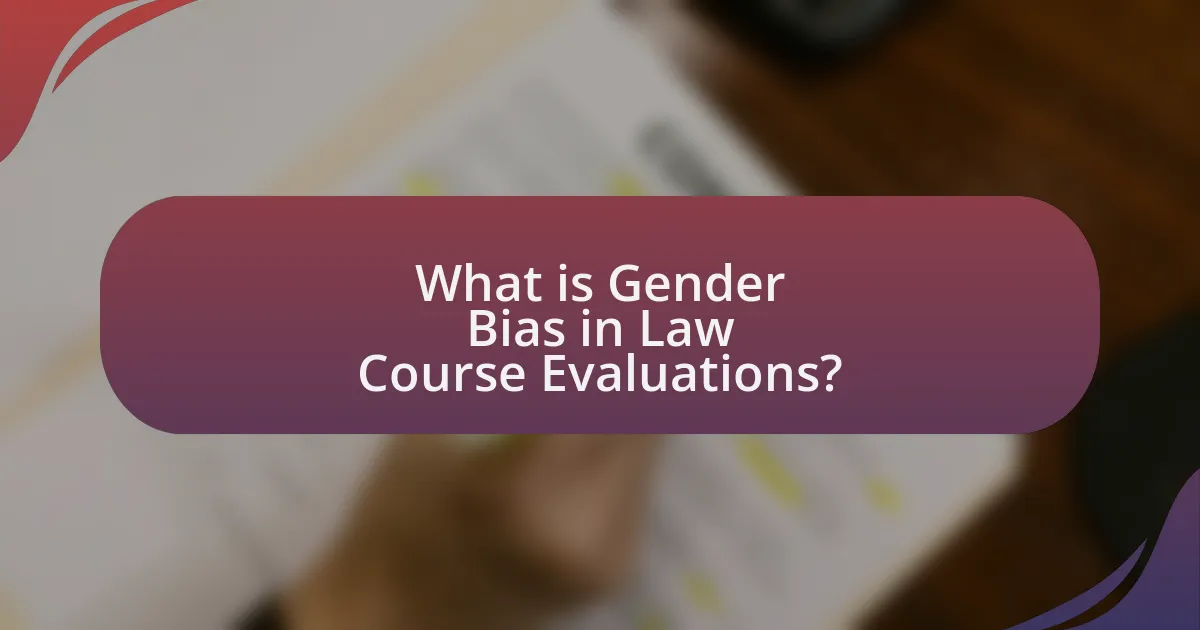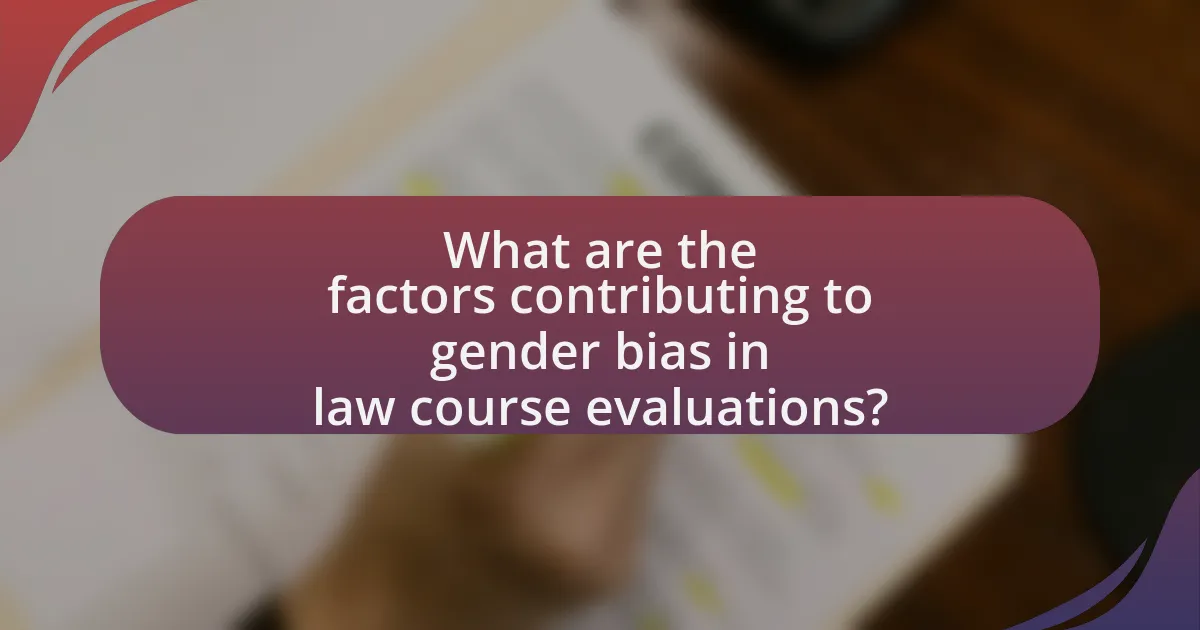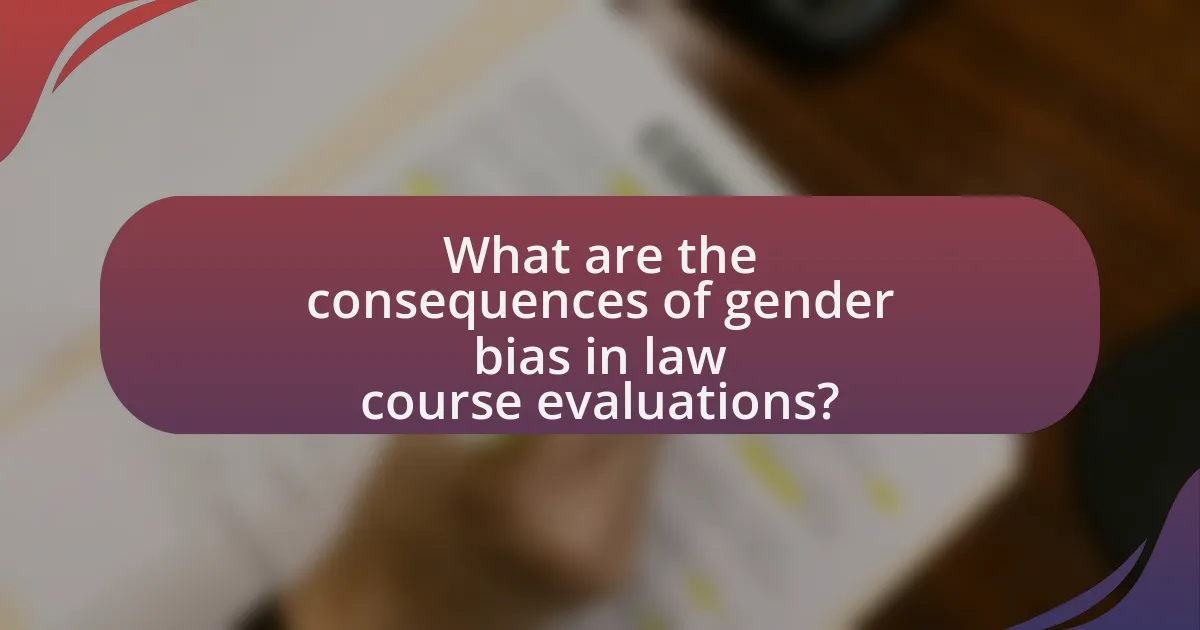Gender bias in law course evaluations refers to the systematic differences in how male and female instructors are assessed, often resulting in lower ratings for female faculty despite similar teaching effectiveness. Research indicates that this bias affects hiring, promotion, and retention of female faculty, perpetuating gender inequality in legal education. Key indicators of gender bias include discrepancies in feedback and grading practices, with studies showing that female instructors and students frequently receive harsher evaluations. Understanding and addressing these biases is crucial for fostering an equitable educational environment and improving the overall effectiveness of legal education. The article explores the factors contributing to gender bias, its impact on students and faculty, and strategies for mitigating its effects in academic settings.

What is Gender Bias in Law Course Evaluations?
Gender bias in law course evaluations refers to the systematic differences in how male and female instructors are assessed by students, often resulting in lower ratings for female faculty. Research indicates that female law professors frequently receive harsher evaluations compared to their male counterparts, even when teaching the same material and exhibiting similar teaching effectiveness. A study published in the Journal of Legal Education found that students’ perceptions of gender influenced their evaluations, with female instructors facing biases that negatively impacted their scores. This bias can affect hiring, promotion, and retention of female faculty in law schools, perpetuating gender inequality in legal education.
How is gender bias defined in the context of law education?
Gender bias in the context of law education is defined as the unequal treatment or perception of individuals based on their gender, which can manifest in various aspects such as classroom interactions, grading practices, and faculty evaluations. Research indicates that female law students often receive lower evaluations compared to their male counterparts, despite similar performance levels, highlighting systemic biases in assessment practices. Studies, such as those conducted by the American Bar Association, reveal that these biases can adversely affect women’s participation and success in legal education, perpetuating gender disparities in the legal profession.
What are the indicators of gender bias in evaluations?
Indicators of gender bias in evaluations include discrepancies in feedback, differential grading practices, and variations in the language used to describe male and female students. Research shows that female students often receive less favorable comments and lower grades compared to their male counterparts for similar performance levels. For instance, a study published in the journal “Psychological Science” found that evaluators tend to use more critical language when assessing women, which can negatively impact their overall evaluations. Additionally, biases may manifest in the form of stereotypes influencing the expectations of performance based on gender, leading to unequal assessment outcomes.
How does gender bias manifest in student feedback?
Gender bias in student feedback manifests through differential evaluations based on the instructor’s gender, often resulting in female instructors receiving lower ratings than their male counterparts despite similar teaching effectiveness. Research indicates that students may unconsciously apply gender stereotypes, leading to harsher critiques of female educators, particularly in traditionally male-dominated fields like law. For instance, a study published in the journal “Psychological Science” found that female instructors were rated lower on competence and likability, which directly impacts their overall evaluations. This bias can perpetuate systemic inequalities in academic settings, affecting hiring, promotion, and retention of female faculty.
Why is it important to explore gender bias in law course evaluations?
Exploring gender bias in law course evaluations is important because it directly impacts the fairness and effectiveness of legal education. Gender bias can lead to skewed evaluations that do not accurately reflect a professor’s teaching abilities, potentially affecting career advancement and job security for female faculty. Research indicates that female instructors often receive lower ratings than their male counterparts, even when teaching the same material, which can perpetuate systemic inequalities in academia. Addressing this bias is essential for creating an equitable educational environment that values diverse teaching styles and perspectives.
What impact does gender bias have on students and faculty?
Gender bias negatively impacts both students and faculty by perpetuating inequality and affecting academic performance. For students, gender bias can lead to lower self-esteem and reduced participation in classroom discussions, as studies show that female students often receive less encouragement and recognition compared to their male counterparts. For faculty, gender bias can result in disparities in hiring, promotion, and evaluation processes, with research indicating that women faculty members frequently face harsher scrutiny and lower ratings in course evaluations, which can hinder their career advancement. This systemic bias ultimately undermines the educational environment, affecting overall institutional effectiveness and student outcomes.
How can understanding gender bias improve legal education?
Understanding gender bias can improve legal education by fostering a more equitable learning environment and enhancing the quality of legal training. By recognizing and addressing gender bias, legal educators can develop curricula that promote inclusivity and ensure that all students, regardless of gender, receive equal opportunities to participate and succeed. Research indicates that gender bias can affect student evaluations and perceptions of competence, which can lead to disparities in academic and professional advancement. For instance, a study published in the Journal of Legal Education found that female faculty members often receive lower evaluations than their male counterparts, despite similar teaching effectiveness. This awareness allows institutions to implement strategies that mitigate bias, such as standardized evaluation criteria and bias training for evaluators, ultimately leading to a more just and effective legal education system.

What are the factors contributing to gender bias in law course evaluations?
Factors contributing to gender bias in law course evaluations include stereotypes about gender roles, differences in student expectations, and the impact of instructor gender on evaluations. Research indicates that students often hold implicit biases that affect their perceptions of male and female instructors, leading to harsher evaluations for women. For instance, a study published in the Journal of Legal Education found that female law professors received lower ratings compared to their male counterparts, even when teaching identical courses. Additionally, societal norms may influence students to expect different teaching styles from male and female instructors, further skewing evaluations.
How do societal norms influence evaluations in law schools?
Societal norms significantly influence evaluations in law schools by shaping the criteria and expectations that faculty and students use to assess performance. These norms often reflect broader cultural attitudes towards gender, race, and class, which can lead to biased evaluations. For instance, research has shown that female law professors receive lower evaluations than their male counterparts, even when teaching the same material and exhibiting similar teaching styles. A study published in the Journal of Legal Education found that students’ perceptions of competence are often influenced by gender stereotypes, which can skew evaluation outcomes. This demonstrates that societal norms not only affect individual perceptions but also institutional practices in law school evaluations.
What role does the perception of teaching effectiveness play?
The perception of teaching effectiveness significantly influences student evaluations and academic outcomes. Research indicates that students’ perceptions of a teacher’s effectiveness can affect their engagement, motivation, and overall satisfaction with the course. For instance, a study published in the Journal of Educational Psychology found that positive perceptions of teaching effectiveness correlate with higher student performance and retention rates. This suggests that how students perceive their instructors directly impacts their learning experience and academic success.
How do stereotypes affect student evaluations of female professors?
Stereotypes negatively impact student evaluations of female professors by leading to biased perceptions of their teaching effectiveness. Research indicates that students often hold implicit biases that associate leadership and authority with male characteristics, which can result in lower ratings for female instructors regardless of their actual performance. A study published in the journal “Psychological Science” by Boring, Ottoboni, and Stark found that female professors received lower evaluations than their male counterparts, even when teaching the same course content and exhibiting similar teaching styles. This evidence highlights the detrimental effect of gender stereotypes on the assessment of female educators in academic settings.
What methodologies are used to study gender bias in evaluations?
Quantitative and qualitative methodologies are used to study gender bias in evaluations. Quantitative methods often involve statistical analyses of evaluation scores, comparing results across genders to identify disparities. For instance, studies may utilize regression analysis to control for variables such as course difficulty and student demographics, revealing patterns of bias in grading. Qualitative methods include content analysis of written evaluations and interviews with students and faculty, providing insights into perceptions and experiences related to gender bias. Research such as “Gender Bias in Student Evaluations of Teaching” by Boring, Ottoboni, and Stark (2016) demonstrates that female instructors receive lower ratings than their male counterparts, highlighting the effectiveness of these methodologies in uncovering bias.
What types of data are collected in gender bias research?
Gender bias research collects various types of data, including quantitative data such as survey responses, course evaluations, and demographic information, as well as qualitative data from interviews, focus groups, and open-ended survey questions. Quantitative data allows researchers to analyze patterns and trends in perceptions of gender bias, while qualitative data provides deeper insights into personal experiences and attitudes regarding gender in educational settings. For instance, studies often examine the impact of instructor gender on student evaluations, revealing significant differences in ratings based on gender, which underscores the presence of bias in academic assessments.
How do researchers analyze evaluation data for bias?
Researchers analyze evaluation data for bias by employing statistical methods and qualitative assessments to identify patterns that indicate potential bias. They often utilize techniques such as regression analysis to examine the relationship between evaluator demographics and evaluation scores, revealing disparities that may suggest bias. For instance, studies have shown that female instructors often receive lower evaluations than their male counterparts, even when teaching identical courses, highlighting a systemic bias in evaluations. Additionally, researchers may conduct content analysis on written feedback to uncover language that reflects gender stereotypes, further supporting the identification of bias in evaluation data.

What are the consequences of gender bias in law course evaluations?
Gender bias in law course evaluations leads to significant disparities in feedback and grading, adversely affecting female instructors’ professional reputations and career advancement. Research indicates that female faculty often receive lower ratings than their male counterparts, even when teaching identical courses, which can result in fewer promotions and opportunities for tenure. A study published in the journal “Psychological Science” found that evaluations of female instructors were influenced by gender stereotypes, leading to a systematic undervaluation of their teaching effectiveness. This bias not only impacts individual careers but also perpetuates a cycle of inequality within academic institutions, discouraging diversity and reinforcing gender imbalances in legal education.
How does gender bias affect faculty hiring and promotion?
Gender bias negatively impacts faculty hiring and promotion by favoring male candidates over equally qualified female candidates. Research indicates that women are often evaluated more harshly than men during the hiring process, with studies showing that identical applications receive different ratings based on the gender of the applicant. For instance, a study published in the Proceedings of the National Academy of Sciences found that both male and female faculty members rated male candidates as more competent and hireable than female candidates, despite identical qualifications. This bias extends to promotion, where women face additional barriers, such as being less likely to be recommended for leadership roles, further perpetuating gender disparities in academia.
What are the long-term effects on female law professors’ careers?
The long-term effects on female law professors’ careers include slower career advancement, lower salaries, and reduced opportunities for tenure compared to their male counterparts. Research indicates that female law professors often face gender bias in evaluations, which can hinder their professional growth and recognition. For instance, a study published in the “Journal of Legal Education” found that female professors received lower course evaluations than male professors, even when teaching the same material, impacting their promotion prospects and salary negotiations. This systemic bias contributes to a persistent gender gap in leadership positions within law schools, affecting the overall representation of women in academia.
How does bias influence the overall academic environment?
Bias significantly influences the overall academic environment by perpetuating inequality and affecting student performance and faculty evaluations. Research indicates that gender bias in course evaluations can lead to lower ratings for female instructors compared to their male counterparts, even when teaching effectiveness is similar. A study published in the journal “Psychological Science” by Boring, Ottoboni, and Stark (2016) found that female instructors received lower evaluations than male instructors, which can impact hiring, promotions, and funding opportunities. This bias not only undermines the credibility of academic assessments but also discourages diversity in faculty representation, ultimately shaping a less inclusive academic culture.
What strategies can be implemented to mitigate gender bias in evaluations?
To mitigate gender bias in evaluations, institutions can implement standardized evaluation criteria that focus on objective performance metrics rather than subjective opinions. Research indicates that using clear rubrics can reduce bias by providing evaluators with specific guidelines to follow, which minimizes personal biases. Additionally, training evaluators on implicit bias and its effects can enhance awareness and promote fairer assessments. A study by Trix and Psenka (2003) found that when evaluators were educated about gender bias, the disparity in evaluations between male and female candidates decreased significantly. Furthermore, anonymizing evaluations can help eliminate identifiers that may trigger bias, leading to more equitable outcomes.
How can law schools train students to provide unbiased feedback?
Law schools can train students to provide unbiased feedback by implementing structured feedback frameworks that emphasize objective criteria and peer review processes. These frameworks can include specific guidelines that focus on the content of the work rather than the identity of the individual providing the feedback. Research indicates that training programs that incorporate bias awareness and sensitivity training can significantly reduce instances of biased evaluations. For example, a study published in the Journal of Legal Education found that law students who participated in bias training were more likely to provide constructive and impartial feedback in course evaluations.
What role does anonymous feedback play in reducing bias?
Anonymous feedback plays a crucial role in reducing bias by allowing individuals to express their opinions without fear of repercussions. This anonymity encourages honest and candid responses, which can reveal underlying biases that might otherwise go unreported. Research indicates that when feedback is anonymous, evaluators are less likely to let personal biases influence their assessments, leading to more equitable evaluations. For example, a study published in the Journal of Educational Psychology found that anonymous evaluations resulted in a significant decrease in gender bias in student assessments, highlighting the effectiveness of anonymity in promoting fairness.
What best practices can law schools adopt to address gender bias?
Law schools can adopt several best practices to address gender bias, including implementing blind grading, providing bias training for faculty, and establishing clear reporting mechanisms for discrimination. Blind grading removes identifying information from student work, which has been shown to reduce bias in evaluations. Faculty bias training can raise awareness of unconscious biases and promote equitable treatment of all students. Additionally, clear reporting mechanisms empower students to report incidents of bias without fear of retaliation, fostering a safer and more inclusive environment. These practices are supported by research indicating that structured interventions can significantly mitigate gender bias in educational settings.
How can law schools create a more equitable evaluation process?
Law schools can create a more equitable evaluation process by implementing standardized rubrics that minimize subjective bias in grading. Research indicates that subjective evaluations often reflect gender biases, with studies showing that female students receive lower evaluations than their male counterparts for similar performance levels. By utilizing clear, objective criteria for assessments, law schools can ensure that all students are evaluated based on their actual performance rather than perceived biases. Additionally, training faculty on implicit bias and its effects on grading can further enhance fairness in evaluations, as evidenced by programs that have successfully reduced bias in academic settings.
What initiatives have been successful in reducing gender bias in evaluations?
Successful initiatives in reducing gender bias in evaluations include the implementation of blind grading systems, which anonymize student submissions to eliminate bias based on gender. Research conducted by the National Bureau of Economic Research found that blind grading significantly improved the performance of female students in evaluations, demonstrating a reduction in gender bias. Additionally, training evaluators on implicit bias has proven effective; studies show that awareness of biases can lead to more equitable evaluations. These initiatives collectively contribute to a fairer assessment environment in educational settings, particularly in law courses.
What are the future directions for research on gender bias in law course evaluations?
Future research on gender bias in law course evaluations should focus on developing standardized evaluation metrics that minimize bias, exploring the impact of instructor gender on student evaluations, and examining the long-term effects of biased evaluations on career trajectories. Studies have shown that female instructors often receive lower evaluations compared to their male counterparts, even when teaching the same material, indicating a systemic bias that warrants further investigation. Additionally, research should analyze how different demographic factors, such as race and age, intersect with gender bias in evaluations, providing a more comprehensive understanding of the issue.
How can ongoing studies contribute to policy changes in legal education?
Ongoing studies can contribute to policy changes in legal education by providing empirical evidence that highlights existing biases, such as gender bias in course evaluations. For instance, research has shown that female law professors often receive lower evaluations than their male counterparts, despite similar teaching effectiveness. This data can inform policy discussions and lead to the implementation of more equitable evaluation processes, ensuring that all educators are assessed fairly. By systematically analyzing evaluation trends and their impact on faculty hiring, promotion, and retention, ongoing studies can drive reforms that promote gender equity in legal education.
What emerging trends should researchers focus on in the future?
Researchers should focus on the integration of artificial intelligence and machine learning to analyze gender bias in law course evaluations. This trend is supported by the increasing availability of large datasets and advanced analytical tools that can uncover patterns of bias in student evaluations. For instance, studies have shown that AI can effectively identify language that reflects gender bias, allowing for more nuanced understanding and intervention strategies. Additionally, interdisciplinary approaches combining legal studies, gender studies, and data science are emerging, which can provide comprehensive insights into the systemic issues surrounding gender bias in educational assessments.



